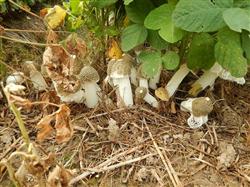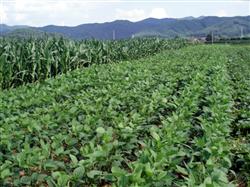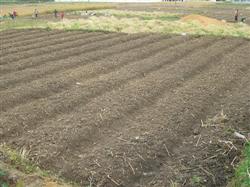How does Dictyophora grow raw materials without shed?

How does Dictyophora grow raw materials without shed? Please introduce Dictyophora, known as the "fungal queen", is a valuable edible fungus in China. Since the successful cultivation of Dictyophora in the field in Gutian County, Fujian Province in the early 1990s, it has been inoculated in the spring of that year, and the bacteria culture has entered the harvest period. the yield of Dictyophora per square meter reaches 250 grams 350 grams, and the high yield reaches 500 grams. The production cycle is shortened by 2/3 and the per unit yield is increased by 10 times. In recent years, new breakthroughs have been made in cultivation techniques. The "cultivation method of various forms without shed with raw materials" is adopted, which not only has a stable and high yield, saves labor and materials, and reduces costs, but also broadens the field of cultivation and solves the contradiction of "mushroom grain competing for land". It makes a new leap in the production of Dictyophora. First, the principle of greenhouse-free cultivation of Dictyophora: through various experiments, we have mastered the strong ability of mycelium to resist miscellaneous bacteria; it can pass through the antagonistic line of many microorganisms and sprout and thrive hyphae in its community. Even if the culture medium has been occupied by other organisms, once it comes into contact with the hyphae of Dictyophora, it can catch up on the contaminated substrate, especially Dictyophora. According to the observation, it is mainly the extracellular enzymes secreted by bamboo sun hyphae, which can fully decompose and absorb nutrients in raw meal, while most of the spore of miscellaneous bacteria are difficult to germinate and colonize on raw meal. the strength of each other leads to an advantage in the growth and development of bamboo sun mycelium. The cultivation of Dictyophora is mostly used in the cultivation of Dictyophora elongata at high temperature, and its fruiting body growth and development period is from June to September every summer. At this time, the stems and leaves of various crops such as soybean, corn, sorghum and melons are in full bloom; in summer, orchards, forest farms, forest and fruit trees are covered with good shading conditions; and the above-mentioned crops and forest fruit trees exhale a large amount of oxygen every day, which is very beneficial to the production and development of bamboo sun. these natural environmental conditions create an organic biological chain for greenhouse-free cultivation of Dictyophora. 2. Selection and treatment of raw materials: there are "five categories" of raw materials for cultivation of Dictyophora: 1. Dictyophora: the roots, leaves, branches, slices, shavings and stems of bamboo regardless of "size, new and old, life and death" can be used, as well as the waste materials from the bamboo processing plant. 2. Miscellaneous trees: they can be made without fragrant oils and other miscellaneous trees. 3. Straw: the straw of other crops can be used except rice straw and wheat straw. 4. Weeds: more than 10 kinds of common herbs such as Reed, Reed and taro can be cultivated. 5. Shells: grain hull, peanut shell, corncob and bean shell can all be used as culture medium. Raw material treatment is a key link related to the cultivation of Dictyophora with raw materials. Raw material treatment requirements: 1, sun-drying: whether bamboo or wood, weeds and straws, should be sun-dried, because fresh bamboo and wood itself contain alkaloids, which make the living tissue necrotic in the material after sun-drying. at the same time, alkaloids are also volatile. 2. Cutting: the cutting and breaking of raw materials is mainly to destroy the whole, so that the living tissue of plants is easy to die, and the cut raw materials are easy to be decomposed and absorbed by hyphae. 3. Soaking: the soaking method of raw materials is usually alkalized. Put bamboo into the pool, wood chips or other scraps can be packed in gunny bags and woven into the pool, and then add 0.3% 0.5% lime for every 100 kg of material, soak the material in water for 24 minutes, exceeding the effect of disinfection and sterilization. After filtration, rinse repeatedly with clean water until the PH value is about 7, remove and drain to 60% 70% water content for production. 4. Using bagasse, cottonseed hull, corn stalk, soybean, grain hull, peanut stalk, rape stalk and other straw cultivation, the above proportion of lime water can be poured into the material and can be used after being stuffed for 8 or 10 hours. Third, greenhouse-free cultivation forms and techniques 1. Interplanting crops beside the border (1) cultivation season: Dictyophora cultivation is generally divided into spring and autumn. The temperature in the north and south of our country is different, so we should master two points: one is that the temperature during the sowing period is not more than 28 ℃, which is suitable for the growth and development of hyphae; the other is the development period of buds 2-3 months after sowing, and the temperature is not less than 10 ℃, which makes the buds grow healthily into fruiting bodies. Dictyophora interplanting crops in southern provinces are usually sown in spring, "stinging" begins, heap sowing, and "Qingming Festival" begins to interplant crops. (2) site arrangement: first open the drainage ditch, the width of the bed is 1 meter, the length of the bed depends on the site, generally 10 to 15 meters, there is a pedestrian passage between the bed and the bed, 20 to 30 centimeters wide, the border bed is "tortoise back", 25 centimeters and 35 centimeters from the bottom of the furrow to prevent stagnant water. (3) sowing method: Dictyophora is sown with one layer of material and one layer of seed, and the strain can be sowed or sowed on demand, with 10 kg of culture material per square meter and 3 bottles of bacteria, so as to pile up materials and sow seeds at the same time. (4) mulch cover: after sowing, cover the surface of the border bed with a layer of humus soil 3 cm thick, and the water content of humus soil should be 18%. After covering the soil, cut it into small pieces with bamboo leaves or reeds, cover the surface, and cover the bed with thin film. (5) interplanting crops: after 15-20 days of covering soil beside the Dictyophora border bed, you can dig holes beside the border to sow crop seeds and interplant one tree at intervals of 50-60 cm. (6) Field management: after sowing, the hyphae will climb onto the material surface and cover the bed with awn dustpan (wolf coat) or thatch for 30 days at normal temperature, which is beneficial to the formation of mushroom buds. After culture, the mycelium proliferated continuously, absorbed a lot of nutrients, formed a fungal cord and climbed onto the material surface, transferred from vegetative growth to reproductive growth, quickly turned into a bacterial bud, and broke the stalk to form a solid. The suitable water content of the culture medium in the mushroom stage is 60%, and the water content of the covered soil is less than 20%, which requires the air technique to have a humidity of 85%. During the growth period of buds, water must be sprayed once in the morning and evening, and it is better to keep the relative humidity not less than 85%. During the growth period of buds, water must be sprayed once in the morning and evening, and the relative humidity should be maintained at 85%. The bulge of the buds gradually appeared at the top, and then broke the handle and scattered the skirt in a short time. Dictyophora spray requires "four looks": first, look at the cover, when the bamboo leaves or stalks become dry, spray water: second, look at the soil. Cover the soil white, to spray more, spray frequently; three look at the buds. Buds small, light spray, fog spray; bacteria buds mostly spray, re-spray; four look at the weather. Large evaporation in sunny and dry days, more spray, no spray in cloudy and rainy days. Only in this way can we ensure that the buds grow well, the mushrooms grow well, and the flowers are beautiful. 2. Interplanting Dictyophora among forest and fruit can make use of the space in apple, citrus, grape, nai, peach, pear and other orchards, as well as the tree space in mountain woodland, so as to improve land utilization. Specific measures: (1) Garden plot arrangement: choose the fruit of flat land or gentle slope, sandy loam containing humus, orchard near water source. Clean up sundries and weeds on the site 7-10 days before sowing, and it is best to turn the soil and expose it. The head of fruit trees can be sprayed with Bordeaux liquid to control diseases and pests. In general, the spacing of fruit trees is 3 × 3 meters, in which the open space is used as a border bed for Dictyophora planting. Shun fruit tree trench for border, sidewalk spacing of 30 cm, border width of 60 cm 80 cm, the soil should not be too broken, to facilitate ventilation, leaving 40 cm to 50 cm beside the fruit tree, as a rice road. (2) heap sowing: pre-wet the culture material before sowing, and the water content is about 60%. Choose a sunny day to remove 3 centimeters of the soil layer, push it to both sides of the border, and leave it for covering soil; then pile the prepared culture material on the border bed, and then sow Dictyophora bacteria on the material. If the branches and leaves are not dense, cover the soil with a layer of awn dustpan and thatch to avoid direct sunlight. After sowing, lime or other pesticides should be sprinkled around the ditch and around the site to kill insects. (3) germ management: 15-20 days after sowing, generally there is no need to spray water, it is best to uncover the film and ventilation for about 30 minutes a day, increase the number of ventilation in the later stage, and keep the water content of the culture material 60-70%. There is a lot of rain during the Spring Festival. Dig a good drainage ditch, which is 30 centimeters deeper than the bed. The growth temperature of mycelium was the most suitable for 23 ~ 26 ℃. (4) mushroom production management: after sowing for 40-50 days, the mycelium could grow full of culture material, and after 10-15 days, the mycelium reached physiological maturity and climbed onto the soil. When the normal temperature is above 20 ℃, the mushroom buds can grow after 10-15 days, and the humidity is maintained at 80-90%. At the normal temperature, after 20-25 days of cultivation, the buds will mature and can be harvested at this time. 3. Bamboo head non-material bionic cultivation of Dictyophora generally adopts in-situ old bamboo hole sowing method. Choose to cut down the bamboo head for more than 2 years, next to the bamboo head uphill direction, dig a hole, the size of 5 cm 6 cm, depth 20 cm 25 cm, the acupoint filled with rotten bamboo leaves 5 cm thick. After sowing a layer of Dictyophora fungus, fill a layer of rotten bamboo leaves 10 cm thick, then sow another layer of bacteria, according to this, fill 2-3 layers, and finally cover 2-3 cm thick with rotten bamboo leaves and dug out soil, and gently step on them. If the soil is dry, it should be watered and moisturized, covered with weeds, branches and leaves for sun and wind, moisturizing and heat preservation. When the strain is sown, pay attention to less sowing in the lower layer and multi-sowing in the upper layer, so as to make the hyphae better go to the dead bamboo whip after the hyphae is restored. Can also be taken in the bamboo forest from high to low, every 25 to 30 centimeters to dig a small trench, 7 to 10 centimeters deep, the bottom of the ditch pad with a little tofu or bamboo whip, sprinkled with bacteria, and then covered with soil. Generally, there are 180 and 200 old bamboo heads per mu of bamboo forest. Digging flowers costs money, and it is difficult to rot. Dictyophora can be used in situ to decompose bamboo heads and have the best of both worlds. The cultivation of Dictyophora by using the old bamboo head depends entirely on the natural environmental conditions, so it is appropriate to sow the seeds from March to April in spring, when the spring returns to the earth, and the temperature is wet and suitable for mycelium growth. Dictyophora is not resistant to drought and waterlogging, so the acupoint drainage ditch should be dredged. During drought, it is better to water and moisturize, not less than 60%. It is watered every 15-20 days in winter and every 3-5 days in summer. Watering should not be too hasty to prevent washing away the surface cover leaf layer. The soil water content should always be kept at 15-18%. It is necessary to cut down a certain amount of bamboo every year and increase the bamboo whip humus so that the hyphae have a new source of nutrition every year. Cultivated land must be cultivated once a year in winter to get rid of weeds and loosen the soil so that the hyphae can get a certain amount of oxygen. Click to get more planting techniques of Dictyophora, click to get more planting techniques of edible fungi
- Prev

How to interplant soybean with Dictyophora?
How to interplant soybean with Dictyophora? Please introduce Dictyophora interplanting soybeans to solve the problem of sunshade, save costs, and increase the income of soybeans in the first season. The following planting methods are for reference: first, the cultivation season: according to the local climatic conditions and the growth characteristics of Dictyophora, the suitable cultivation season is when the temperature is stable for 7 ℃ and 30 min.
- Next

How to grow bamboo shoots in the field
How to grow bamboo shoots in the field? Jing gives detailed introduction to field planting Dictyophora can refer to the following methods: 1. Cultivation season "D89 Dictyophora" is a mesophilic fungus, the local temperature is stable at 8-28℃ for the cultivation period, the city generally February-April for the sowing period, May-October (temperature is not lower than 16℃) for the long mushroom...
Related
- Fuxing push coffee new agricultural production and marketing class: lack of small-scale processing plants
- Jujube rice field leisure farm deep ploughing Yilan for five years to create a space for organic food and play
- Nongyu Farm-A trial of organic papaya for brave women with advanced technology
- Four points for attention in the prevention and control of diseases and insect pests of edible fungi
- How to add nutrient solution to Edible Fungi
- Is there any good way to control edible fungus mites?
- Open Inoculation Technology of Edible Fungi
- Is there any clever way to use fertilizer for edible fungus in winter?
- What agents are used to kill the pathogens of edible fungi in the mushroom shed?
- Rapid drying of Edible Fungi

